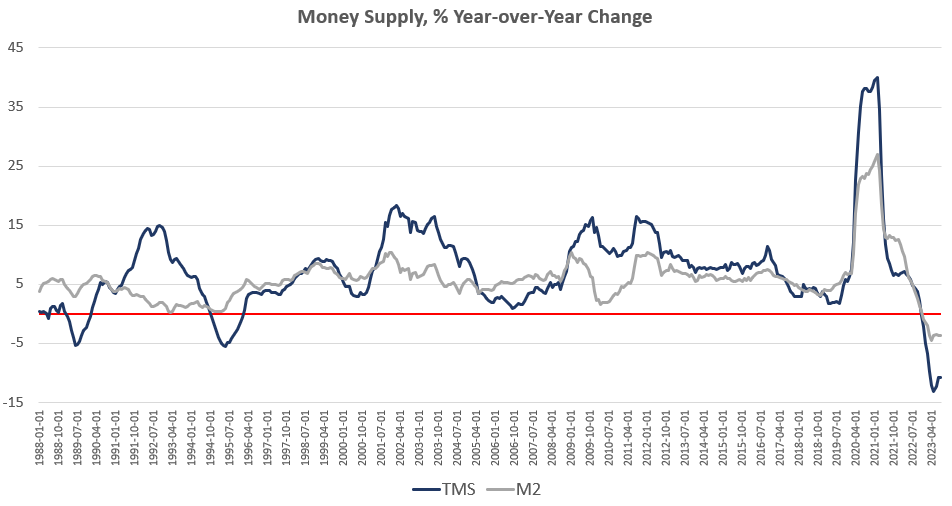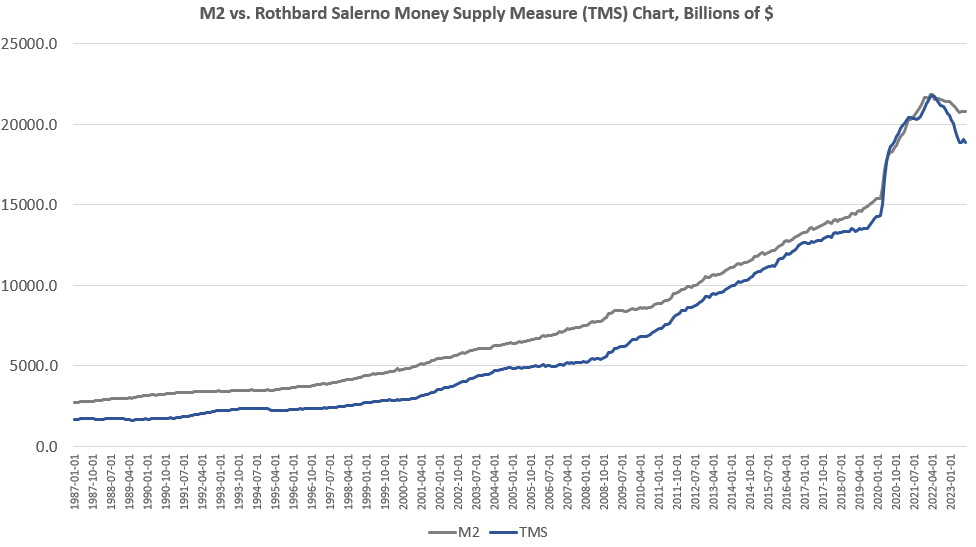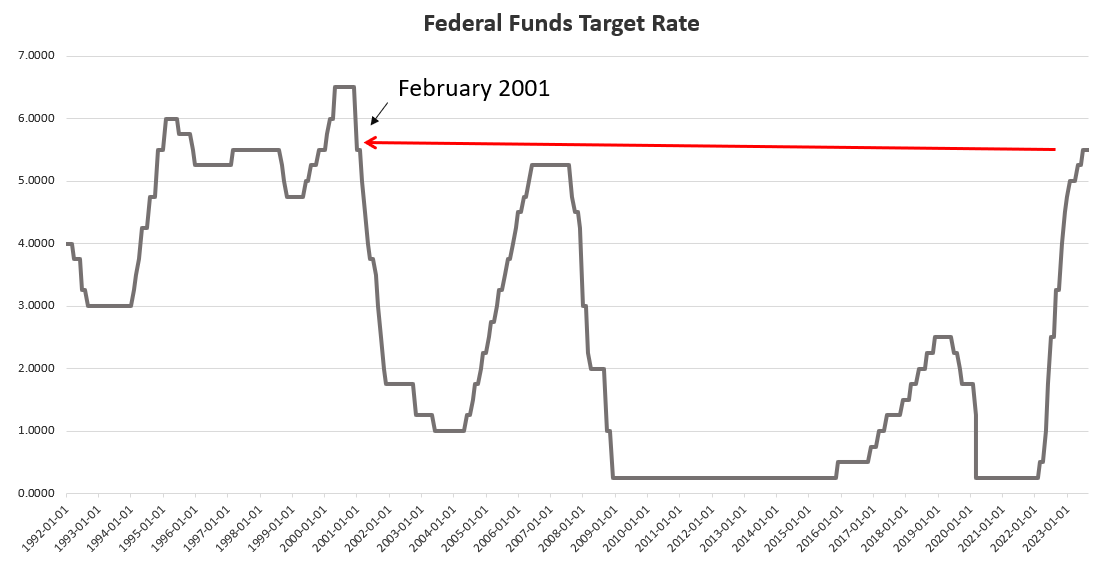Money supply growth fell again in August, remaining deep in negative territory after turning negative in November 2022 for the first time in twenty-eight years. August's drop continues a steep downward trend from the unprecedented highs experienced during much of the past two years.
Since April 2021, money supply growth has slowed quickly, and since November, we've been seeing the money supply repeatedly contract year over year. The last time the year-over-year (YOY) change in the money supply slipped into negative territory was in November 1994. At that time, negative growth continued for fifteen months, finally turning positive again in January 1996.
Money-supply growth has now been negative for ten months in a row. During August 2023, the downturn continued as YOY growth in the money supply was at –10.8 percent. That's unchanged from July's rate of –10.8 percent, and was far below August 2022's rate of 4.4 percent. With negative growth now falling near or below –10 percent for the sixth month in a row, money-supply contraction is the largest we've seen since the Great Depression. Prior to this year, at no other point for at least sixty years has the money supply fallen by more than 6 percent (YoY) in any month.
The money supply metric used here—the "true," or Rothbard-Salerno, money supply measure (TMS)—is the metric developed by Murray Rothbard and Joseph Salerno, and is designed to provide a better measure of money supply fluctuations than M2.
The Mises Institute now offers regular updates on this metric and its growth. This measure of the money supply differs from M2 in that it includes Treasury deposits at the Fed (and excludes short-time deposits and retail money funds).
In recent months, M2 growth rates have followed a similar course to TMS growth rates, although TMS has fallen faster than M2. In August 2023, the M2 growth rate was –3.7 percent. That's unchanged from July's growth rate of –3.7 percent. August 2023's growth rate was also well down from August 2022's rate of 3.8 percent.
Money supply growth can often be a helpful measure of economic activity and an indicator of coming recessions. During periods of economic boom, money supply tends to grow quickly as commercial banks make more loans. Recessions, on the other hand, tend to be preceded by slowing rates of money supply growth.
It should be noted that the money supply does not need to actually contract to signal a recession and the boom-bust cycle. As shown by Ludwig von Mises, recessions are often preceded by a mere slowing in money supply growth. But the drop into negative territory we've seen in recent months does help illustrate just how far and how rapidly money supply growth has fallen. That is generally a red flag for economic growth and employment.
The fact that the money supply is shrinking at all is remarkable because the money supply in modern times almost never gets smaller. The money supply has now fallen by $2.9 trillion (or 13.4 percent) since the peak in April 2022. Proportionally, the drop in money supply since 2022 is the largest fall we've seen since the Depression. (Rothbard estimates that in the lead-up to the Great Depression, the money supply fell by 12 percent from its peak of $73 billion in mid-1929 to $64 billion at the end of 1932.)
In spite of this recent drop in total money supply, the trend in money-supply remains well above what existed during the twenty-year period from 1989 to 2009. To return to this trend, the money supply would have to drop at least another $3 trillion or so—or 15 percent—down to a total below $15 trillion.
Since 2009, the TMS money supply is now up by nearly 185 percent. (M2 has grown by 142 percent in that period.) Out of the current money supply of $18.8 trillion, $4.6 trillion—or 24 percent—of that has been created since January 2020. Since 2009, $12.2 trillion of the current money supply has been created. In other words, nearly two-thirds of the total existing money supply have been created just in the past thirteen years.
With these kinds of totals, a ten-percent drop only puts a small dent in the huge edifice of newly created money. The US economy still faces a very large monetary overhang from the past several years, and this is partly why after eighteen months of slowing money-supply growth, we are not yet seeing a sizable slowdown in the labor market. The inflationary boom has not yet ended.
Nonetheless, the monetary slowdown has been sufficient to considerably weaken the economy. The Philadelphia Fed's manufacturing index is in recession territory. The Leading Indicators index keeps looking worse. The yield curve points to recession. Temp jobs were down, year-over-year, which often indicates approaching recession. The credit card default rate is rising rapidly.
Money Supply and Rising Interest Rates
An inflationary boom begins to turn to bust once new injections of money subside, and we are seeing this now. Not surprisingly, the current signs of malaise come after the Federal Reserve finally pulled its foot slightly off the money-creation accelerator after more than a decade of quantitative easing, financial repression, and a general devotion to easy money. As of September, the Fed has allowed the federal funds rate to rise to 5.50 percent, the highest since 2001. This has meant short-term interest rates overall have risen as well. In September, for example, the yield on 3-month Treasurys reached the highest level measured in more than 20 years.
Without ongoing access to easy money at near-zero rates, however, banks are less enthusiastic about making loans, and many marginal companies will no longer be able to stave off financial trouble by refinancing or taking out new loans. The banking sector itself has warned investors to prepare for new rounds of layoffs. Meanwhile, large corporate bankruptcy filings surged in the first half of the year. According to a new report from Cornerstone Research:
“The surge in large corporate bankruptcy filings in the first half of 2023 is consistent with economic conditions posing heightened bankruptcy risk for highly leveraged companies,” said Matt Osborn, a principal at Cornerstone Research and coauthor of the report. “Along with a general rise in interest rates, credit spreads for highly leveraged corporate issuers compared to investment grade issuers began widening in mid-2022, a shift that generally persisted into the first half of 2023.”
The number of mega bankruptcies, those filed by companies with over $1 billion in reported assets, also increased. In the first half of 2023, the number of mega bankruptcies already matched the full-year total for 2022 of 16 and surpassed the 2005–2022 half-year average of 11. The largest bankruptcy was filed by SVB Financial Group, with $19.68 billion in assets at the time of filing. The largest non-financial-firm bankruptcy filing was by Bed Bath & Beyond Inc., with $4.40 billion in assets at the time of filing. Six mega bankruptcies were filed by companies in the Services industry.
Lending for private consumption is getting more expensive also. This week, the average 30-year mortgage rate rose to the highest point reached since the year 2000.
These factors all point toward a bubble that is in the process of popping. The situation is unsustainable, yet the Fed cannot change course without reigniting a new surge in price inflation. Although some professional economists insist that price inflation has all but disappeared, the sentiment on the ground is clearly one in which most workers believe their wages are not keeping up with rising prices. Any surge in prices would be especially problematic given the rising cost of living. Ordinary Americans face a similar problem with home prices. According to the Atlanta Fed, the housing affordability index is now the worst it's been since 2006, in the midst of the Housing Bubble.
If the Fed reverses course now, and embraces a new flood of new money, prices will only spiral upward. It didn't have to be this way, but ordinary people are now paying the price for a decade of easy money cheered by Wall Street and the profligates in Washington. The only way to put the economy on a more stable long-term path is for the Fed to stop pumping new money into the economy. That means a falling money supply and popping economic bubbles. But it also lays the groundwork for a real economy—i.e., an economy not built on endless bubbles—built by saving and investment rather than spending made possible by artificially low interest rates and easy money.
Full story here Are you the author? Previous post See more for Next postTags: Featured,newsletter

























